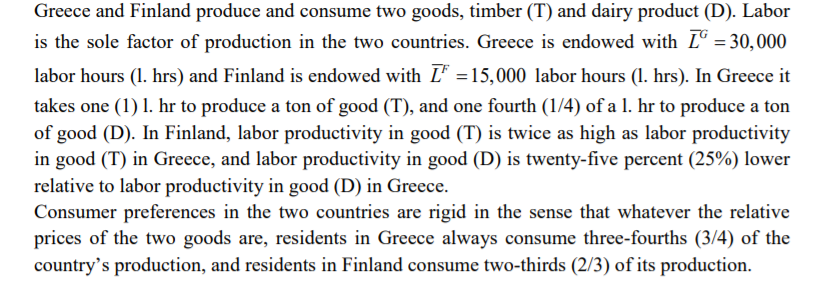Greece and Finland produce and consume two goods, timber (T) and dairy product (D). Labor is the sole factor of production in the two countries. Greece is endowed with Lº = 30,000 labor hours (1. hrs) and Finland is endowed with L' =15,000 labor hours (1. hrs). In Greece it takes one (1) 1. hr to produce a ton of good (T), and one fourth (1/4) of a 1. hr to produce a ton of good (D). In Finland, labor productivity in good (T) is twice as high as labor productivity in good (T) in Greece, and labor productivity in good (D) is twenty-five percent (25%) lower relative to labor productivity in good (D) in Greece. Consumer preferences in the two countries are rigid in the sense that whatever the relative prices of the two goods are, residents in Greece always consume three-fourths (3/4) of the country's production, and residents in Finland consume two-thirds (2/3) of its production.
Greece and Finland produce and consume two goods, timber (T) and dairy product (D). Labor is the sole factor of production in the two countries. Greece is endowed with Lº = 30,000 labor hours (1. hrs) and Finland is endowed with L' =15,000 labor hours (1. hrs). In Greece it takes one (1) 1. hr to produce a ton of good (T), and one fourth (1/4) of a 1. hr to produce a ton of good (D). In Finland, labor productivity in good (T) is twice as high as labor productivity in good (T) in Greece, and labor productivity in good (D) is twenty-five percent (25%) lower relative to labor productivity in good (D) in Greece. Consumer preferences in the two countries are rigid in the sense that whatever the relative prices of the two goods are, residents in Greece always consume three-fourths (3/4) of the country's production, and residents in Finland consume two-thirds (2/3) of its production.
Advanced Engineering Mathematics
10th Edition
ISBN:9780470458365
Author:Erwin Kreyszig
Publisher:Erwin Kreyszig
Chapter2: Second-order Linear Odes
Section: Chapter Questions
Problem 1RQ
Related questions
Question
Question:
Calculate the relative wage between the two countries, and briefly comment on your
finding.

Transcribed Image Text:Greece and Finland produce and consume two goods, timber (T) and dairy product (D). Labor
is the sole factor of production in the two countries. Greece is endowed with Lº = 30,000
labor hours (1. hrs) and Finland is endowed with L' =15,000 labor hours (1. hrs). In Greece it
takes one (1) 1. hr to produce a ton of good (T), and one fourth (1/4) of a 1. hr to produce a ton
of good (D). In Finland, labor productivity in good (T) is twice as high as labor productivity
in good (T) in Greece, and labor productivity in good (D) is twenty-five percent (25%) lower
relative to labor productivity in good (D) in Greece.
Consumer preferences in the two countries are rigid in the sense that whatever the relative
prices of the two goods are, residents in Greece always consume three-fourths (3/4) of the
country's production, and residents in Finland consume two-thirds (2/3) of its production.
Expert Solution
This question has been solved!
Explore an expertly crafted, step-by-step solution for a thorough understanding of key concepts.
Step by step
Solved in 2 steps

Recommended textbooks for you

Advanced Engineering Mathematics
Advanced Math
ISBN:
9780470458365
Author:
Erwin Kreyszig
Publisher:
Wiley, John & Sons, Incorporated

Numerical Methods for Engineers
Advanced Math
ISBN:
9780073397924
Author:
Steven C. Chapra Dr., Raymond P. Canale
Publisher:
McGraw-Hill Education

Introductory Mathematics for Engineering Applicat…
Advanced Math
ISBN:
9781118141809
Author:
Nathan Klingbeil
Publisher:
WILEY

Advanced Engineering Mathematics
Advanced Math
ISBN:
9780470458365
Author:
Erwin Kreyszig
Publisher:
Wiley, John & Sons, Incorporated

Numerical Methods for Engineers
Advanced Math
ISBN:
9780073397924
Author:
Steven C. Chapra Dr., Raymond P. Canale
Publisher:
McGraw-Hill Education

Introductory Mathematics for Engineering Applicat…
Advanced Math
ISBN:
9781118141809
Author:
Nathan Klingbeil
Publisher:
WILEY

Mathematics For Machine Technology
Advanced Math
ISBN:
9781337798310
Author:
Peterson, John.
Publisher:
Cengage Learning,

